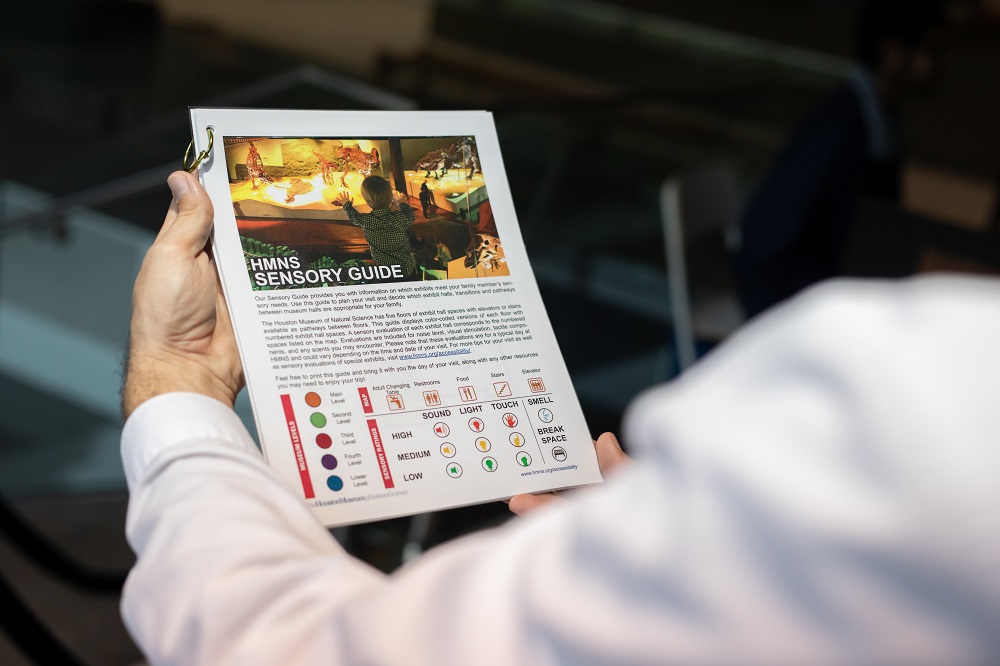In celebration of World Autism Day and Autism Awareness Month, we’re highlighting how super our visitors with Autism Spectrum Disorders are and sharing a few educational resources for you to explore! As a person who does not have Asperger’s or a related Autism Spectrum Disorder, it can be hard for me to imagine what it feels like or how your brain might experience a visit to a museum like HMNS.
Doing research, talking with families, and watching YouTube videos can help give me an idea of what it might feel like, but I can never fully have that experience myself. It’s important to be knowledgeable about what this might feel like because it’s part of my job at HMNS to create resources for patrons who may require help or advice in navigating our museum. Equally so, it’s vital to be understanding and empathetic to the experiences of other people. Here are some videos that I’ve found that have been personally enlightening:
What I imagine is that this place can feel SUPER overwhelming and large to some, and SUPER exciting and energizing to others based on individual differences in sensory processing. I’ve talked with visitors on the spectrum who love to visit the tactile exhibits and enjoy the noises, opportunity for sensory output, and multitude of objects to touch, and I’ve talked with visitors who walk into the Grand Hall and immediately request sunglasses and headphones to subdue the amount of sensory input. As someone who is very passionate about understanding people with Autism Spectrum Disorders and assisting them in the best way possible, I ask myself… what exactly in a person’s brain causes those magnified experiences? Pretty sure it’s super powers, but being the nerd that I’ve become after working at HMNS for years, I was curious about finding the true, scientific answer.
What I’ve found is that there are many different explanations and theories about this! Some studies relate these different experiences to the evolution of advanced mental processing, sensory behavioral differences, and social motivation deficits, and others relate it to cognitive differences such as brain structural changes, differences in concentrations of neurotransmitters, and disordered cortical connectivity, among many others.

All this to say, people with Autism Spectrum Disorders experience things differently from what some would call “neurotypical” people, and also experience things differently from each other, much like everyone else in the world! A coworker shared this comic strip with me, and I think it is really helpful in changing the perspective on what “being on the spectrum” means. As explained in the comic, “the spectrum” is not a lateral line, but more of a sphere of different ranges of ways the brain processes sensory input, social interactions, communication, perception, executive function, and movement. I think this is a wonderful visual for understanding individuals who may experience or process things a little differently. It’s also a great resource to keep in mind when you interact with someone who has an Autism Spectrum Disorder.
During this time of increasing social-distance, various educational institutions such as schools, zoos and museums are sharing countless virtual resources that can be used as learning tools for individuals on the spectrum. HMNS is committed to educating the community, including those with ASDs, with #HMNSatHome. Exhibits from dinosaur fossils to cultural histories of Native American peoples are only a click away with our online collection. Also, follow HMNS on Facebook, Twitter, Instagram and YouTube for daily doses of education.

If you’re teaching your own kiddos at home, please take advantage of our resources, and check out some of our peer institutions’ resources as well! We know it can be challenging to find yourself homeschooling unexpectedly and having to explain an unprecedented event to someone with an Autism Spectrum Disorder, so we want you to know that we, and our friends at other museums and cultural institutions, are here to support you and your loved ones!
- Links to various educational resources and tips for caregivers of people with ASD
- Social Story Explaining Coronavirus
- COVID-19 Toolkit for those supporting someone with ASD
Though our physical doors are closed, our virtual doors remain open. Finding ways to creatively bring science to you is our highest priority. Your contributions matter today more than ever, as we strive to continue full pay for staff during this time and ensure that the museum is ready and able to welcome you back. Please GIVE TODAY to help support our mission of science education.

